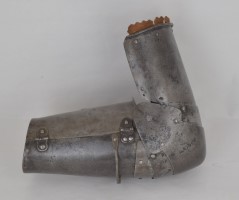
Arm circa 1430
Extremely rare example of a 15th c. piece of armour. Arm for the left arm. Perhaps from the fortress at Chalcis (Negroponte). Formed of a tubular upper cannon that wraps two thirds of the way around the arm connected to a bluntly-pointed cop with an abbreviated wing by one lame. The cop is then connected to a tulip-shaped vambrace formed of two pieces hinged on the outside by hinges and secured by a strap and buckle on the inside. The cop is connected to the vambrace by two lames. The second lame is attached to the vambrace by means of 3 lateral slots allowing the arm to rotate. The lower edge of the vambrace is bordered by a line of small rivets. The lower cannon is marked by an indistinct maker's mark involving a split cross. The upper edge of the upper plate with a narrow, outward-turned roll and a line of rivets securing a (later) leather used to lace the armour to the arming doublet. The inner plate of the vambrace, one lame, lisiere d'arret, one half of one hinge, and all of the rivets replaced. The character of these restorations is similar to the restorations on the Rhodes pieces in the Royal Armouries. Given Claude Blair's association with the Royal Armouries and the presence of the letters HRR on the inside of the inner vambrace plate it is likely that this piece was restored there (HRR almost certainly represents H. Russell Robinson). From the personal collection of Claude Blair. For similar examples see Stephen V. Granscay, The Bashford Dean Collection of Arms and Armour...., 1933, nos. 76-81, pl. V. The most detailed record of the pieces discovered at Chalcis see C. J Ffoulkes, An Italian Armour from Chalcis in the Ethnological Museum at Athens, Archaeologia, LXII (1911) pp. 381-390.
Measurements 39 cm long. The arm is 15 in. long overall when straight, upper cannon 5 1/2 in. tall at the center of the cop, 4 5/16 in. wide at the top, 4 3/16 in. wide at the bottom. The upper cannon is 8 1/8 in. around the circumference. The roll at the top of the upper cannon is 1/8 in. tall and 3/16 in. deep. Lower cannon 7 1/4 in. long at the center of the cop, 3 7/8 in. wide at the elbow, 2 5/8 in. wide at the wrist. The cop 3 1/4 in. tall at the center, 2 in. tall at the wing, 1 1/2 in. tall at the back. The slots in the vambrace for rotation are 5/8 in. wide. The hinges are 3/4 in. wide, the upper one is 1 3/8 in. long. The inside measurements of the buckle are 3/4 in. on the wide side of the trapezoid, 5/8 in. on the short side and 5/16 in. tall. The thickness varies significantly. The upper cannon is .040-.090 in., mostly .050-.070 in. The thickest part in the center. The cop is .050-060 on the back and .070-.080 on the front. The outer plate of the lower cannon is generally .070-.080 in the upper center and .050-.060 near the wrist. The upper lame is app. .030 in. and the lower one .040 in.
Weight 2 pounds 7.2 ounces (1,110 g).
Not for sale.
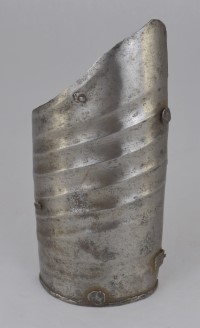
Outer vambrace plate circa 1480-1500
From a late 15th century German 'splint' vambrace. Surface covered with diagonal flutes. 2 horzontal flutes paralleling the wrist. Simple outward fold at the wrist. Inside includes a separate strip running vertically that forms a slot for the hand protection. This is very atypical - these were usually attached by placing a slot in the main plate. The vambrace covers the outer third of the arm.
8 1/2 in. long at the outside and 5 3/4 in. long at the inside. It is 6 in. wide at the top and tapers (very slightly) to 5 3/4 in. at the wrist. Normally a vambrace tapers more than this, but splints which include hand protection that slides inside the vambrace need to be much more tubular.
Thickness .028' - .048', mostly .030 - .035.
Similar interior plate on the early 16th c. splint with vertical fluting typical of the period in the Bayerische Armeemuseum Ingolstadt splint with inventory number A633?. An interior picture of it taken by Michael Koepff is illustrated for comparison.
Not for sale.
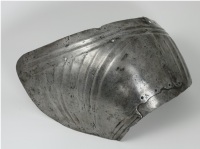
Pauldron circa 1480-1500
Main plate from a pauldron. One piece with radiating flutes in the back, parallel horizontal flutes at the top and vertical flutes on the side. The front appears to have been unfluted. Together with a modern copy made as a mate. This was in the Granscay collection, the well made mate was likely made by the armourers at the Metropolitan Museum of Art. The original has significant modern patches riveted inside.
Not for sale.
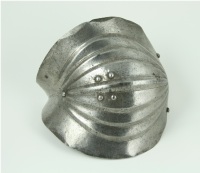
Two couters circa 1490
A pair of elbows - one is authentic, the other a well made copy. Each of shell form, pointed at the outside of the elbow and with a flare at the inside of the bend of the elbow. The outer surface covered by three stepped flutes on each side and a central squared raised ridge. Each of these is accentuated by an engraved line at the base of the step. The outer edge is decorated by a series of five cusps. The back and inside of the wing are plain. The cops have modern straps and have four holes at the center to secure the cop to the arm. Four holes are usually indicative of laces, but these holes appear to be smaller than would be normal for this. The form, decorative elements and four holes indicate a late 15th century date for the elbow.
Measurements: Elbow thickness varies significantly reflecting the rough interior surface - a few thick areas app. .060, thin areas app. .030. Varies significantly even in spots close to each other often between .040 and 050 in one area of the center. It appears this elbow was shaped roughly and ground to its smooth surface, not hammered to the exact shape.
Weights: elbow: 7.4 ounces (210g).
Not for sale.
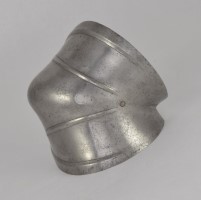
Elbow (couter) circa 1500
Floating form designed for use with a central peg securing it to a strap connecting the upper and lower vambrace. Clam shell form with one flute above and below the center and raised border over most of the outer edge. Ex. col. Dr. John Waldman.
Measurements: weight 7.8 ounces (225g) thickness mostly .035-.045 with smaller areas as thin as .028 and as thick as .062 inch. The thinnest spot is near the point.
Not for sale.
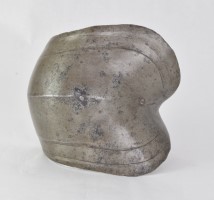
Couter (elbow cop) circa 1500
Formed in a single piece wrapping two thirds of the way around the arm. With a raised ridge bordered by a parallel recessed border around outer edge of the wing and front of the cop, each accented by an engraved line. One rivet at the center to secure a leather connecting the cop to the vambrace and rivet and hole to secure a strap around the elbow. The cop formed with a blunt medial ridge forming a shallow point. This elbow is formed in a plain style that may be of either German or Italian origin. From the personal collection of Claude Blair.
Weight: 1 pound (460g).
Measurements 18.5 cm wide. 6 5/8 in. tall at the widest part of the wing, 5 in. tall at the back edge, and 6 in. from the point of the center of the wing to the back edge. Thickness .050-.080, generally in the .060-.075 range.
Not for sale.
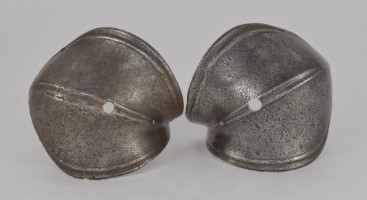
Pair of Elbow cops circa 1500
German. A pair, both pitted, one with a large internal patch. Each of small, shell form with fluted border and engraved lines. Rising to a central fluted ridge, also accented by engraved lines. There is a hole in the center which would have engaged a pin in a leather strap that connected the cops to the vambrace. There are also two rivets at the back and one in the wing to secure a strap across the inside of the elbow. Ex. Col. Dr. Peter Parsons.
Measurements 5 1/4 in at the widest spot, 4 3/4 in. from the inside of the back to the inside of the inner point of the wing. The central hole is 7/16 in. in diameter. Thickness varies between .040 and .070. Generally thickest about 1/2 in from the center ridge flowing up to the point, thinning toward the central crease and toward the edge. Most of the area in the back, wing and outer edge is .040-.050.
Not for sale.
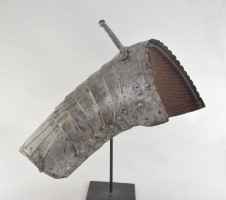
Pauldron circa 1500
For the right shoulder. Fluted at the center of the arm and heavily fluted in the back of the main plate. Flutes asymmetric with engraved lines on both sides accenting the form of the flute. Upper edge of the main plate filed to rounded tabs. The rear edge of the main plate with bent down cusps. Center of the main plate with a sculpted peg to secure the lance when held over the shoulder. Originally part of a Stech armour of very high quality. A pair of pauldrons of similar form are illustrated on plate 73 of Katalog Der Leibrustkammer I teil. They are dated 1497. That pair are somewhat more plain. There are several other pairs of Stech pauldrons in the KHM. The most plain is on S VII - Stechzeug made in Innsbruck and dated 1483/4. Other similar pauldrons include WA 24 and S XVI. This one is purportedy from the collection at Schloss Grafenegg. The plates have a very nice form, overall tapering to the arm and flaring out in the front where it would overlap the breastplate and aggressively curved in the back where it would fit over the shoulder blades. Top plate or plates missing. The cusped border would not be on a terminal plate, the top plate should have a roll.
Measurements: Thickness varies mostly between .075 and .050 in. The thickness is a little random, like most authentic pieces, but the front of the main plate and several of the lower plates is the thickest part of the piece. The thickest spot on the main plate is just in front of the post. Some portions of the 3rd and 4th plates reach .080 in. The terminal plate is more generally around .050 in. There is some odd variability, but the general pattern places the thickest material in the front and side in areas which would not be covered by other plates.
Not for sale.
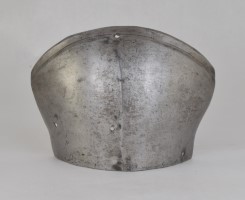
Spaulder plate circa 1510
Main plate from a left spaulder. Nice shape swelling at the top. Central vertical crease. Upper edge with a recessed band as a decorative (and stiffening) border. A single hole for a buckle at the center of the top. 3 holes for attachment of the other plates - one near the back corner for a sliding rivet, the other two at the center and front, placed higher for the attachment of leathers.
4 3/4' tall, 6 1/4' wide at the widest point.
.028-.038' thick. Generally slightly thinner at the middle.
Not for sale.
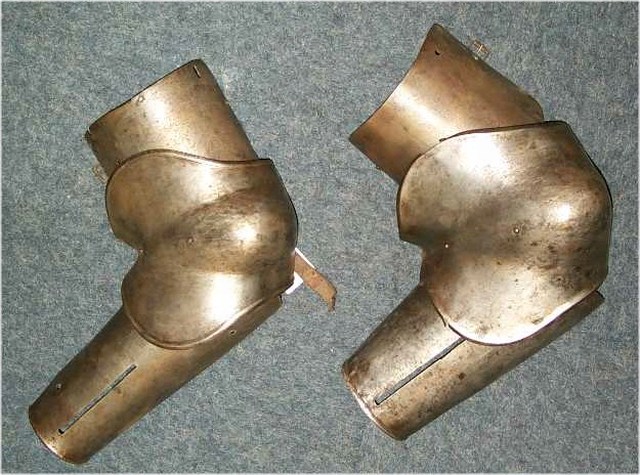
Two left Italian or possibly south german splint arms circa 1510
Two similar elbows with associated arm pieces. Both for the left arm. Each with gutter shaped upper cannon (one restored), boldly formed couter with flanged upper and lower edges. One of the edges forms a half roll with a parallel incised line, the other has a bent up and then down edge. Tapering lower cannon cut with a long slot to accomadate the hand defences. Italian, or possibly south German. The lower arms appear to have been adapted to form a splint simulating a lower quality arm. Originally the vambraces appear to have formed parts of normal full vambraces. The elbows are the interesting elements. They represent examples of an early 16th c. form of large floating elbow that leads to the maximillian form when flutes are added. The elbows would have been secured to the upper and lower arms by a leather strap in the front and (if all of the existing holes are original) another at the back. Then the elbow would be secured to the arm by means of a Y strap secured at two points at the back and one in the center of the front which would be closed by a buckle. From the collections of the Counts Schenk von Stauffenberg.
Similar ones are preserved in Madonna Delle Grazie - Mantova on the armour B9, and the Royal Armouries housed at the Tower of London and Leeds (from Rhodes).
Maximum width of the wing 8 in. 5 5/8 in. at the back edge. From center of elbow crease to point of cop 7 1/4 in.
Measurements of the slightly larger copy with beveled edge - thickness of the wing area .022-.030 in. back of the cop mostly .030, some areas down to .025, others up to .052 in. front of cop mostly .040-.050 in.
Weight: first elbow 11 ounces (310 g), second elbow including the leather straps and buckle 12.8 ounces (365 g). Parts catalogued separately as item number A-63a, item number A-63b, item number A-63c, item number A-63d, item number A-63e.
Not for sale.
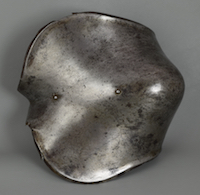
Left Italian or possibly south german elbow circa 1510
One elbow for the left arm. boldly formed couter with flanged upper and lower edges. The edges are bent up then down forming a simple ridge. Italian, or possibly south German. This represents an example of an early 16th c. form of large floating elbow that leads to the maximillian form when flutes are added. From the collections of the Counts Schenk von Stauffenberg.
Similar ones are preserved in Madonna Delle Grazie - Mantova on the armour B9, and the Royal Armouries housed at the Tower of London and Leeds (from Rhodes). Originally purchased as part of the composed left arms item number A-63.
Not for sale.
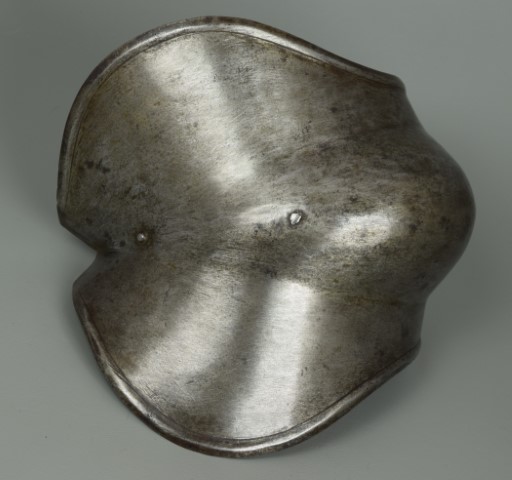
Left Italian or possibly south german elbow circa 1510
For the left arm. Boldly formed couter with flanged upper and lower edges. The edges form a half roll with a parallel incised line. Italian, or possibly south German. The elbows are the interesting elements. They represent examples of an early 16th c. form of large floating elbow that leads to the maximillian form when flutes are added. From the collections of the Counts Schenk von Stauffenberg.
Similar ones are preserved in Madonna Delle Grazie - Mantova on the armour B9, and the Royal Armouries housed at the Tower of London and Leeds (from Rhodes). Originally purchased as part of the composed left arms item number A-63.
Not for sale.
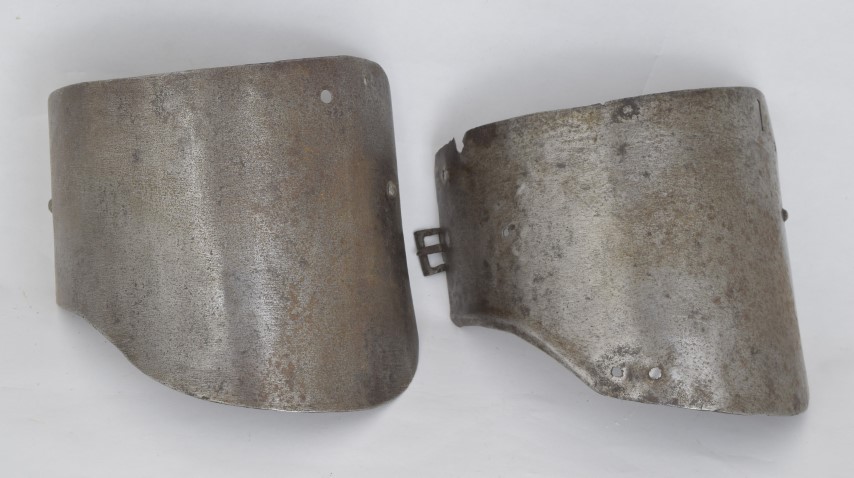
Two left Upper vambrace plates circa 1510
Gutter shaped plates. One of the period, one a restoration. Both for the left arm. Cut out at the elbow. The old one with a simple bump at the inside of the elbow. Originally purchased as part of the composed left arm item number A-63.
Not for sale.
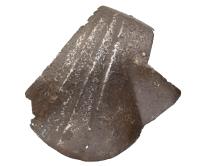
Pauldron circa 1510
Flemish or Italian. The main plate of a pauldron. Large rounded rear section fitted to the backplate and accented with a spray of flutes. Outer edge reinforced with a narrow inward turn. Front fitted to the arm at the bottom and flared at the top to fit over the breastplate. An early 16th c. form which shows the development from the classic 15th c. Italian pauldron to the typical 16th c. form. This main plate would have overlapped the upper and lower plates. It is similar in construction to those on the Henry VIII silvered and engraved armour. Believed to have come from the Knights of St. John at Rhodes.
Not for sale.
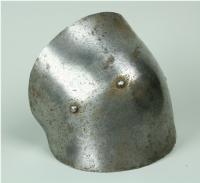
Elbow circa 1510
Of simple shell form covering the outside of the elbow and gently shaped to the inside of the elbow. Rounded form over the point of the elbow. Retains later leathers to secure the elbow to the upper and lower arm plates and a strap and buckle around the elbow. Some minor losses to the rear corner. This would have formed part of a splint arm for a simple infantry armour of the early 16th century known as an Almain Rivet. This piece shows how little an albow can be shaped and still function. Even at this level of work, careful inspection shows that this was designed for use on the left arm. The material is asymmetric - longer on the top side - and the flare is more open on the top and curved on the bottom. Height 5 7/8 in. Thickness generally .038-.041 with an area that is app. 047 in. Weight 6.4 oz.(175g)
Not for sale.
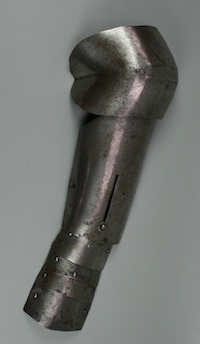
portion of a splint arm protection circa 1510
Consisting of elbow, forarm and hand protection. Elbow covering the outside and point of the elbow with a simple slightly tapered form puckered to fit to the bend of the elbow and with a central band formed by 2 one sided flutes. Forarm of gutter formed with a central slot to secure the hand protection. Hand protection on three leathers. Hand protection of three plates secured to a fourth wrist plate. The slot allows the wrist/hand protection to be retracted. Leathers replaced and broken. Holes for Y strap across the elbow and a strap in the center of the vambrace. The images of the half suit show this piece with additional pieces of armor - item number A-212 and item number A-270 - and a modern upper and right arm made to complete the look. The modern pieces are marked on the interior 'WCA' and are obviously modern rolled steel.
Not for sale.
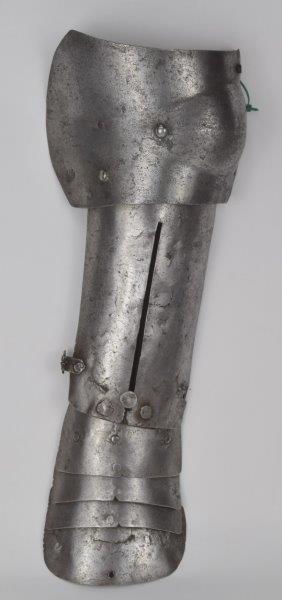
portion of a splint arm protection circa 1510
Consisting of elbow, forarm and hand protection. Elbow covering the outside and point of the elbow with a simple slightly flared form slightly puckered to fit to the bend of the elbow and with a central boss formed with a central crease. Elbow marked with a city stamp. Forarm of gutter formed with a central slot to secure the hand protection. Hand protection on three leathers. Hand protection of three plates secured to a fourth wrist plate. The slot allows the wrist/hand protection to be retracted and adjusted to fit arms of different lengths. Leathers replaced and broken. Holes for strap across the elbow and a strap in the center of the vambrace. It is difficult to determine the original form of the elbow strap since the back has three holes. Two could be used for a Y strap, the central one could be for a straight strap.
Measurements: Thickness (checked in a few places each): vambrace .030-.040, elbow .040-.050, hand .025-.030 inch.
Not for sale.
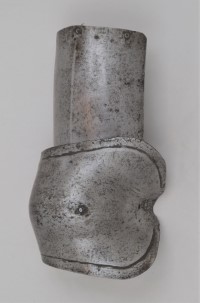
Composed arm harness circa 1510 etc.
Italian floating elbow from 1510. Associated with a later (17th cent.) vambrace, a simple upper vambrace that may form part of the arm with the elbow. The elbow is a simple floating elbow with integral wing. The edges of the wing have a simple rececessed border. The border is app. 1/2' wide and it ends app. 3/4' from the back edge and 1' from the center of the wing. Upper vambrace plate has a central crease and a small half roll at the inside of the elbow. Spaulder plate with a rudimentary central crease and border at the top edge. The front and back of the spaulder cop have been trimmed to adapt it to this arm. The original form was likely very similar to A-56. Together with an associated lame.
Elbow cop - the wing is app 6' tall at the widest spot, tapering to app. 4 1/2' at the back edge. The upper vambrace is app. 7' tall at the back and 5 3/8' tall at the front. It is 6 3/8' wide at the top (measured on the surface). Spaulder cop 5 1/4 in. tall. Vambrace 9 3/8 in. long at the outside, 4 7/8 in. at the inside. 13 1/2 in. around at the widest spot, 9 7/8 in. near the wrist.
The elbow varies from .058 in. to .030 in. Mostly app. .040 in. Upper vambrace thickness varies significantly. It is generally thicker at the front and thinner at the back. It varies from app. .06"" down to .03"". Spaulder cop - .022"" - .045"" thick, the thinnest measurements at the center.
Weight: Elbow and upper vambrace 15.2 ounces (430 g).
Not for sale.
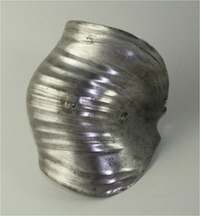
German floating Elbow circa 1510-1520
Simple 'Maximilian' form. Rounded flutes accented by engraved lines. The elbow covers the outer two thirds of the elbow. It represents an example of a somewhat lower quality elbow than is normally displayed on armours in public collections. The elbow would have been secured to the arm using a leather strap between the upper and lower arms and a strap around the elbow.
2 nearly identical elbows are in the Fitzwilliam collection (no.s HEN.M.135A-1933 and HEN.M.135B-1933) identified in the catalogue by Ian Eaves as 1510. Another set is displayed in the Art Institute of Chicago (part of infantry armor dated 1510-15 inv. 1982.2427b-f). A nearly identical splint is preserved at the Bayerische Armeemuseum Ingolstadt (inventory number A633?). Another similar pair is displayed on the suit displayed in the Cleveland Museum of Art lent by the Board of Trustees of the Royal Armouries Inv. II.143 37.2008.
From the R.T. Gwynn collection (Lot 65 from the 2001 Christies sale of the Gwynn collection). Previously purchased by R.A. Lee as lot 40 from the Christies Arms and Armour sale Dec. 17, 1968.
Measurements: 6 1/2 in. tall. Thickness .030-.050, generally around .040. 9 oz (255g).
Not for sale.
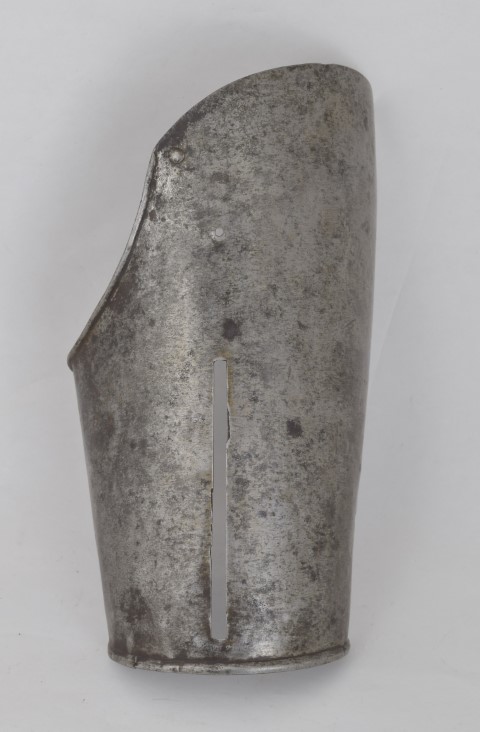
Italian or possibly south german outer vambrace plate circa 1510-1580
Vambrace of one place with a narrow roll at the wrist, narrow outward turned roll at the bend of the elbow, extended at the point of the elbow and with a (possibly) later slot for a splint hand protection. Originally purchased as part of the composed left arm item number A-63.
Not for sale.
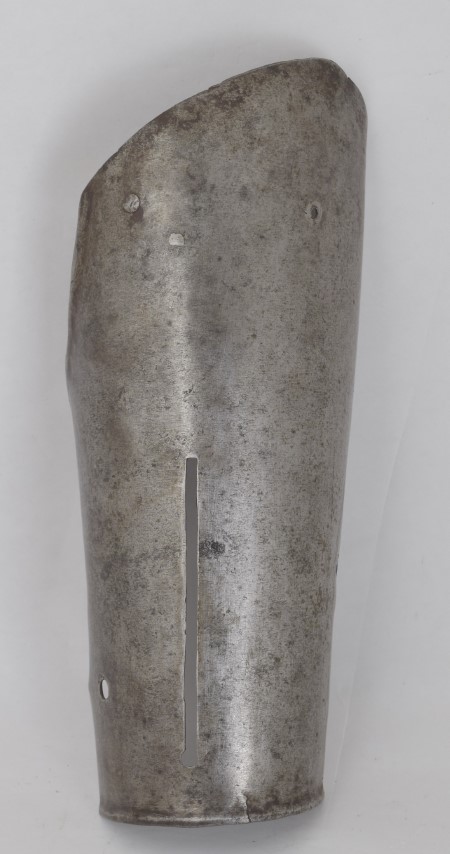
Italian or possibly south german outer vambrace plate circa 1510-1580
Vambrace of one place with a narrow roll at the wrist, narrow simple bump simulating a roll at the bend of the elbow, extended at the point of the elbow and with a (possibly) later slot for a splint hand protection. Originally purchased as part of the composed left arm item number A-63.
Not for sale.
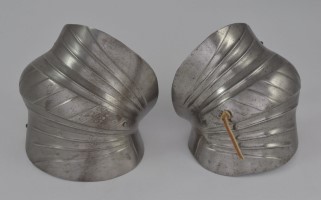
Elbow cop circa 1510-30
Decorated with flutes and recessed bands. A 'floating' cop used with separate upper and lower cannons of the vambrace. The mate is a very well made modern copy (to form a pair). The mate was made in the armouries of the Metropolitan Museum of Art. 7.5 in. tall Thickness varies between .020 and .045, mostly in the .030-035 range. There does not appear to be an intentional pattern in the thickness variation. 10 oz (275 g).
Not for sale.
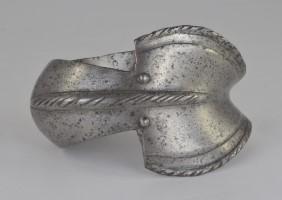
Couter (elbow cop) circa 1520-40
Italian. Of rounded form with a large wing. The outer edge of the wing with inward-turned rolled and roped borders and parallel recessed band. The center of the cop and wing decorated with a large raised and roped ridge. One lame for articulation to the vambrace remains. From the personal collection of Claude Blair.
Measurements 17 cm wide.
Not for sale.
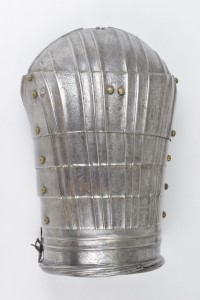
Spaulder circa 1530
Possibly Landshut. Formed of 6 plates, the 2nd overlapping the first and the lower plates. Fluted overall in 4 sets of 3 flutes each. Bands separated by flat areas etched with running foliage and a bird a female figure. The top plate with a plain turn and recessed border which continue onto the to of the second plate. The next 3 plates with plain ends. The final plate with a heavily roped inward-turned roll on the bottom edge and a pair of horizontal flutes. All flutes accented with parallel engraved lines, one on each side of the flute. Retaining its original buckle at the bottom front corner of nice form. Ex. Coll. Dr. John Waldman. 10 3/8 in tall. 1 ound 5.8 ounces (615g). Thickness .030-.050, mainly closer to .040.
Not for sale.
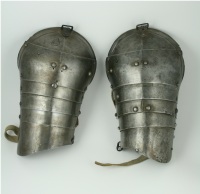
Pair of Spaulders circa 1530
Formed of a main plate with one plate above and five plates below, central crease, and raised and recessed border on the top. The shoulder formed with a nice bulge at the top over the top of the shoulder. The spaulders are typical of the early 16th century.
Not for sale.
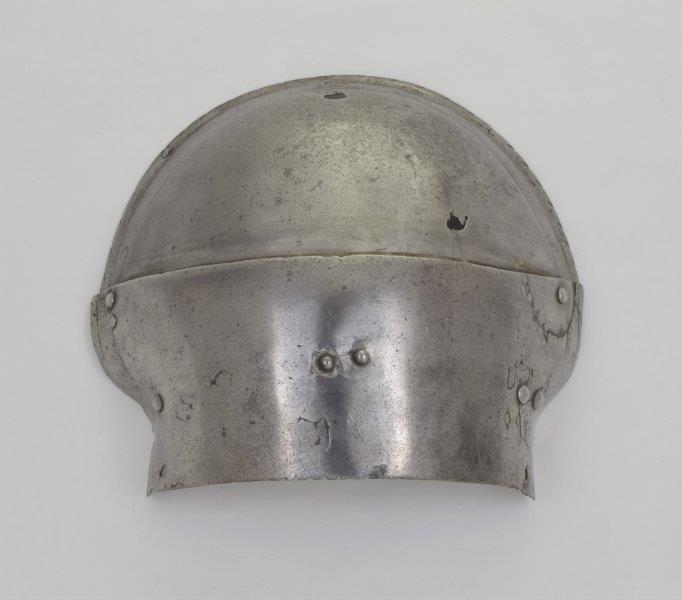
Spaulder (part) circa 1530
South German. The upper two lames of a spaulder. The upper lame shaped to the shoulder with a file roped inward turn and recessed border at the top. The second lame overlapping the first and transitioning the shape from the shoulder to the arm.
Includes an image that compares this to item A-214a. Both are spaulders with an upper moving lame and transition to the arm shape, but this one is much larger and the transition is much more aggressive.
Not for sale.
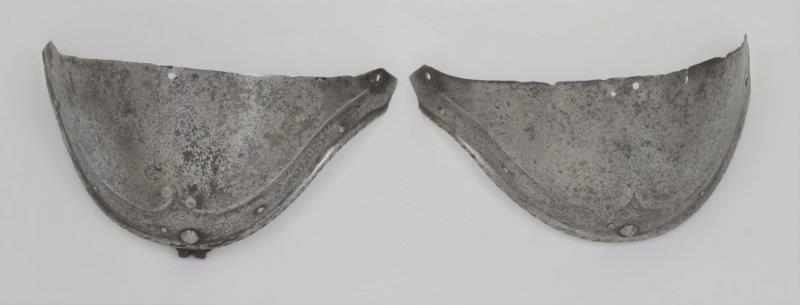
Lower arm lames from almain collar. circa 1540-50
German. Forming a pair. Shaped to the elbow with rolled lower edge with a recessed border etched with scrolling foliage. These have nicer shape than most.
Not for sale.
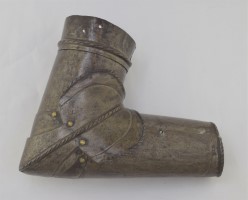
Arm harness circa 1540-60
Formed of an upper and lower vambrace articulated by means of one lame below and one lame above to the bracelet cop. The upper vambrace includes a turning collar which was originally directly attached by a sliding rivet at the back and two leathers to the pauldron. Rolled and roped borders at the wrist and on the edge of the wing. Simple outward rolls at the inner edge of the upper and lower vambraces (at the elbow). Elbow of very pointed form with full bracelet wing. Horizontal raised and roped ridge on the outside from the point of the elbow to the center of the wing. Iron rivets with brass caps articulating the plates and attaching the hinge for the lower vambrace.
Turning collar 4 3/4' in diameter. Lower vambrace 9 3/8' long at the longest point.
Upper cannon .030-.050' thick, lower cannon more even .030-.040' thick.
Not for sale.
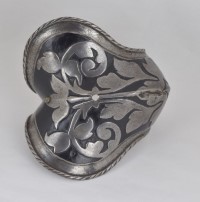
German Black and White Elbow mid 16th cent.
Elbow cop. Floating (originally held to the arm with a strap and buckle around the elbow and a pin suspending it from the upper arm). Decorated with raised foliage against a rough background (likely originally blackened). Raised areas with simple etched decoration. Recessed border with high quality etched decoration of foliage with 'dot' background. This elbow was claimed by the previous owner (optimistically) to have been formerly in the collection of Stephen Granscay. Since he also claimed it was in the Allentown exhibit, maybe he was thinking of the elbow later added to my collection as item number A-221 which better matches the description and includes appropriate collection tags. Traced back to lot 504 from the Sothebys European Works of Art sale held in New York November 25, 1986.
Not for sale.
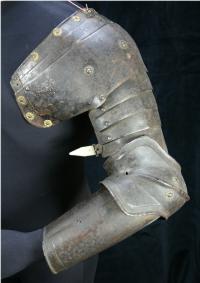
Arm Harness with Pauldron circa 1550
Composed of a pauldron extending to the elbow, a floating cop and a closed vambrace. The pauldron formed of a large plate above and 4 small plates below the main plate. The top plate articulated on rivets, the bottom ones secured by sliding rivets at the back and leathers in the center and front. The upper, front and back edges of the large pauldron plates with inward turned roped rolls and a recessed border. The inner half of the lowest plate with an inward turned and roped roll. The cop open at the back (not a full bracelet) with inward turned, roped turns at the edges. The turns are accompanied by a recessed border on the wing. The center of the cop with a raised roped ridge. The vambrace of two pieces secured by two leather strips at the back and a pin at the front. Inward turned roped rolls at the wrist and the inside of the upper edge at the elbow. Decorative rosettes on the pauldron and elbow. In uncleaned condition from an English household. Later research indicates that this household is Helmingham Hall in Suffolk.
Not for sale.
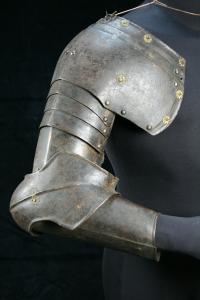
Arm Harness with Pauldron circa 1550
Composed of a pauldron extending to the elbow, a floating cop and a closed vambrace. The pauldron formed of 2 large plates above and 4 small plates below the large central plate. The top, front and back edge of the upper plates and the bottom edge of the lowest plate with roped inward turned roll and a parallel recessed border. The to plates articulated on rivets, the bottom ones secured by sliding rivets at the back and leathers in the center and front. The elbow of bracelet form with inward turns along the edge. Cop of rounded form with a raised central ridge. This cop is formed of 2 pieces. The rounded cop and front wing and a smaller secondary plate forming the inner wing. The vambrace is formed of 2 plates hinged by 2 internal leathers at the front and a pin on the inner plate engaging a hole in the outer plate at the back. The cop and pauldron with rivets with brass rosette washers. The pauldron, cop and vambrace are secured by 2 vertical leather strips riveted to the cop and slotted onto rivets in the pauldron and vambrace. In uncleaned condition from an English household. Later research indicates that this household is Helmingham Hall in Suffolk.
Not for sale.
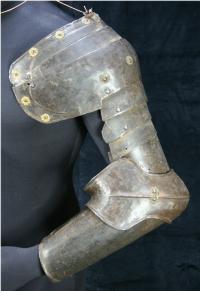
Arm Harness with Pauldron circa 1550
Composed of a pauldron extending to the elbow, a floating cop and a closed vambrace. The pauldron formed of two large plates above and 4 small plates below the large main plate. The top plates articulated on rivets, the bottom ones secured by sliding rivets at the back and leathers in the center and front. The edges of the upper plates with inward turned roped rolls and a recessed border which forms a gentle curve, instead of being parallel to the edge. Cop of rounded form with a raised central ridge. This cop is formed of 2 pieces. The rounded cop and front wing and a smaller secondary plate forming the inner wing. The vambrace is formed of 2 plates hinged by 2 internal leathers at the front and a pin on the inner plate engaging a hole in the outer plate at the back. The cop and pauldron with rivets with brass rosette washers. The pauldron, cop and vambrace are secured by 2 vertical leather strips riveted to the cop and slotted onto rivets in the pauldron and vambrace. In uncleaned condition from an English household. Later research indicates that this household is Helmingham Hall in Suffolk.
Not for sale.
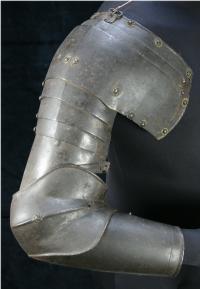
Arm Harness with Pauldron circa 1550
Composed of a pauldron extending to the elbow, a floating cop and a closed vambrace. The pauldron formed of two large plates above and four small plates below the large main plate. The top plates articulated on rivets, the bottom ones secured by sliding rivets at the back and leathers in the center and front. The upper, front and back edges have an inward turned roped roll with a parallel recessed border. The cop of shallow form with a raised, roped central ridge and inward turned rolled and roped edges. The cop wraps app. three quarters of the way around the arm. The vambrace formed of 2 plates secured by two leather strips at the back and a pin at the front. Rolled at the wrist and the inside of the elbow. The cop and pauldron with rivets with brass rosette washers. The pauldron, cop and vambrace are secured by 2 vertical leather strips riveted to the cop and slotted onto rivets in the pauldron and vambrace. In uncleaned condition from an English household. Later research indicates that this household is Helmingham Hall in Suffolk.
Not for sale.
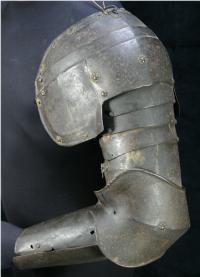
Arm Harness with Pauldron circa 1550
Composed of a pauldron extending to the elbow, a floating cop and a closed vambrace. The pauldron formed of 2 large plates above and 4 small plates below the large central plate. The edge of the upper plates and the bottom edge of the lowest plate with roped inward turned roll and a parallel recessed border. The top plates articulated on rivets, the bottom ones secured by sliding rivets at the back and leathers in the center and front. Cop of angular form. The vambrace is formed of 2 plates hinged by 2 internal leathers at the front and a pin on the inner plate engaging a hole in the outer plate at the back. The cop and pauldron with rivets with brass rosette washers. The vambrace plates secured by two leather strips at the front and a strap and buckle at the back. The pauldron, cop and vambrace are secured by 2 vertical leather strips riveted to the cop and slotted onto rivets in the pauldron and vambrace. In uncleaned condition from an English household. Later research indicates that this household is Helmingham Hall in Suffolk.
Not for sale.
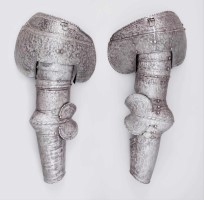
Two Arms with pauldrons mid 16th c.
Pauldrons formed of a large main plate and two underlapping upper plates which extend forward over the chest and back over the back and two additional small plates below that underlap the central plate and connect to the upper plate of the rotating collar of the arms. The outer edges of the pauldron plates with inward turned, roped rolls and a recessed border. Each pauldron has a buckle at the center line of the top plate which would be used to secure the pauldrons to the gorget. In this instance, there is a strap securd to the inside of the pauldron that would engage the buckle. This appears to be a method that was used, but I expect that it was not done orignally on these. Arms of closed upper and lower canons articulated to elbow cops with lames above and bellow (one each on the right arm, two each on the left). Cops of deep rounded form and large wings that wrap half way around the inside of the elbow. Center of the cop with a large raised roped ridge that extends through the center of the wing. Upper canons formed of two tubular plates forming a rotating collar. Each plate closed by an overlapping and riveted seam. The upper plate with raised ridge that engages a flared edge on the top of the lower plate. Lower canons formed of two plates joined by two exterior hinges at the back and a pin on the interior plate that engages a hole in the outer plate. Each with an interior turned and roped roll at the wrist. The lames, cop and lower edge of the rotating collar on the left with cusps filed into the exposed edges.
The pauldrons well matched, almost a pair. The arms less well matched, but likely from the same period. It appears that the left arm and pauldron were originally a unit, the right likely associated - the arm and lower lames of the pauldron having been mated to the upper three lames of the pauldron. The central roped ridge and style of the wings indicate that these arms are almost certainly from the mid 16th c. and Italain or Flemish in origin.
These are well matched to item number A-1. The condition as purchased makes them look similar to item number A-114, with which they are initially displayed.
Not for sale.
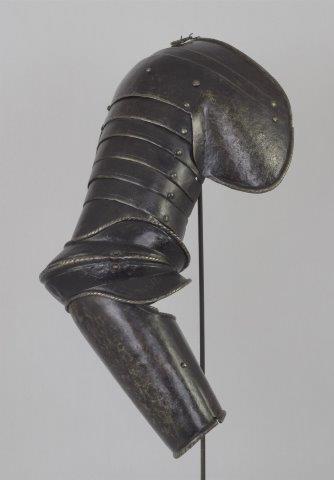
Arm with pauldron circa 1550-60
For the right arm. Rough from the hammer. Consisting of a pauldron of nine plates. The main third plate overlapping those above and below. Pauldron designed for use with floating elbow, elbow gauntlet or without a lower arm. Simple design without a turning collar. Elbow cop of bracelet form, angular shape with prominent central roped band and inward turned roped edges. Vambrace of two plates secured by two external hinges on the back and a pin on the front, wrist and inside of the elbow with inward turned roped borders. Displayed as part of item number A-1.
Not for sale.
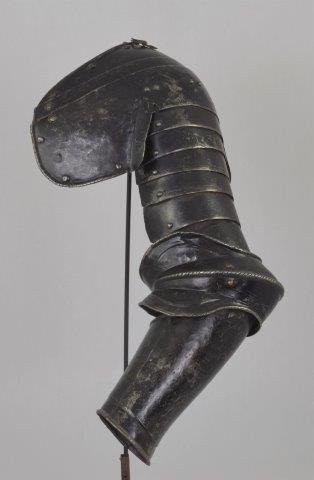
Arm with pauldron circa 1550-60
For the left arm. Rough from the hammer. Consisting of a pauldron of nine plates. The main third plate overlapping those above and below. Pauldron designed for use with floating elbow, elbow gauntlet or without a lower arm. Simple design without a turning collar. Elbow cop of bracelet form, angular shape with prominent central roped band and inward turned roped edges. Vambrace of two plates secured by two external hinges on the back and a pin on the front, wrist and inside of the elbow with inward turned roped borders. Displayed as part of item number A-1.
Not for sale.
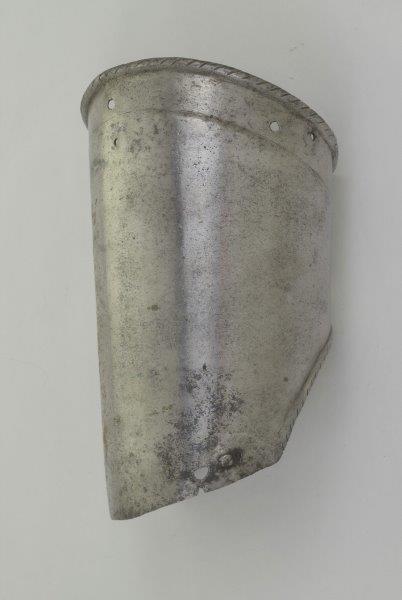
Vambrace upper cannon. circa 1550-60
Italian. Upper cannon of the vambrace. Rolled and recessed border at the top, rolled border at the bottom where it is shaped to the elbow. The style of roped and recessed border points us to this date, but the one piece construction is atypical at this period. More typically an upper canon would include a rotating collar.
Not for sale.
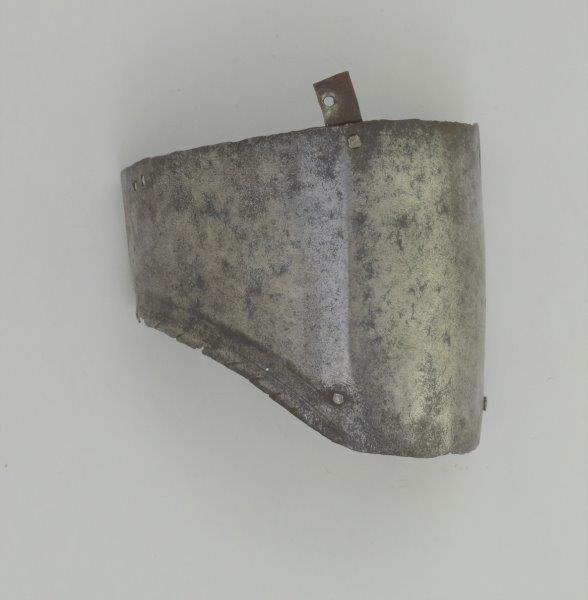
Pauldron lame circa 1550-60
Italian. Terminal plate of a pauldron formed to be used with a floating elbow.
Not for sale.
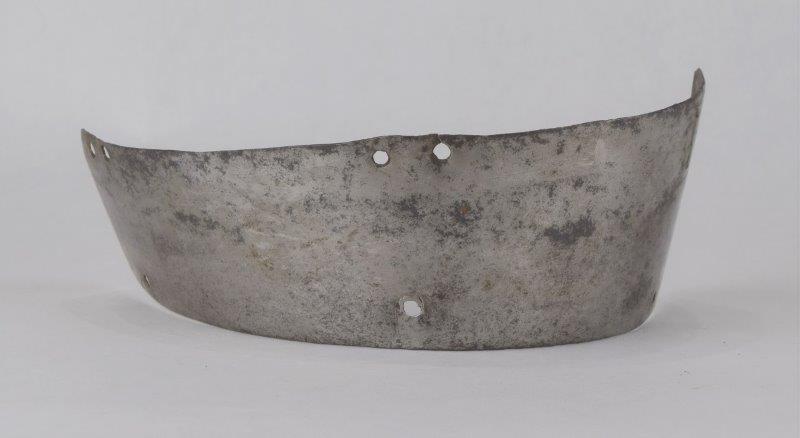
Pauldron lame circa 1550-60
German. Intermediate plate of a left pauldron.
Not for sale.
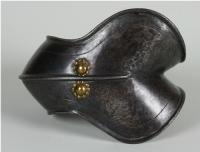
Elbow cop circa 1550-70
For the right elbow. Very finely formed with crisp detail and what is likely the remains of old blued finish over a partially ground rough from the hammer finish. This finish appears to be an original finish with very minimal wear. Outer edge and central band with extremely fine roping. Ex. Col. Stephen Granscay.
Includes two old tags on the inside. One of brass stamped with S V G on one side and 79 on the other side. The other of stiff brownish read cardboard L.64.I4.28.
Exhibited Allentown (#79). Identified as German, 1550 in the Allentown catalogue. It is very similar in form, roping and central decoration to the elbows on 2 armours in Les Armures Des Rois de France au Musee de L'Armee pages 73 and 77. They are identified as 1560 to mid 1570s (this one is much less decorated)
Measurements: The thickness varies - genrally thicker in the cop area and thinner in the wing. The cop mostly .045-055. Wing mostly .025-.035. Weight 10 ounces (285g).
Not for sale.
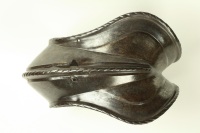
Floating elbow circa 1560
Italian. Of nearly bracelet form. There is a narrow gap of app 1/2 inch between the rear edge of the cop and the wing. The cop is asymetric, being flatter at the back and rising to a peak at the center from slightly behind the point of the elbow through the wing. The wing is slightly larger on one side than the other indicating that this is a right elbow. The outer edges are rolled and roped for their entire length. The roll is bordered by a recessed border on the front portion of the wing. There is a central raised roped band running along most of the raised portion of the cop. There are 2 holes on the front and one at the back for attachment of the cop to the vambrace plates. There is an old collection number in white paint ('178') on the back of the wing. Some delaminations on the inside.
Height of cop app. 3 1/2 inches, and the wing app. 5 inches. Length app. 7 1/2 inches from the point of the elbow to the opposite edge of the wing.
Weight 9.6 ounces (275 g).
Not for sale.
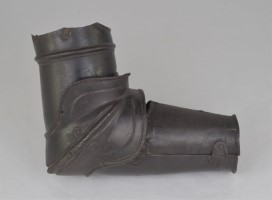
Italian Arm harness circa 1560
Originally designed as a floating arm defense of a rerebrace, couter and vambrace. It has been crudely joined by copper rivets. Couter of bracelet form. The rear edge of the cop overlaps the end of the wing by app. 1/2 inch they are secured by 2 rivets. The end of the wing is recessed so that the outside of the wing and cop are flush. The cop cop is asymetric, being flatter at he back and rising to a peak at the center from slightly behind the point of the elbow through the wing. The wing is symetric. The outer edges are rolled and roped for their entire length (one small portion missing near the center of fhe back). The roll is bordered by a recessed border on the front portion of the wing. There is a central raised roped band running along most of the raised portion of the cop. There are 2 holes on the front and one at the back for attachment of the cop to the vambrace plates. The cop is app. 3 1/2 inches tall and app. 7 inches from the point of the elbow to the opposite edge of the wing. The wing is 5 1/4 inches high. Rerebrace of simple tubular form with rotating collar remaining. Rolled and roped borders at the inside of the elbow and the inside of the edge of the turning collar. The turning collar has one hole in front, a pair of holes at the outside and a slot at the back for the attachment of the pauldron. The vambrace of 2 plates joined by 2 hinges on the outside. The outer plate dished to conform to the forarm. The upper edge of the inner plate with a rolled and roped border. The wrist edge of both plates with rolled and roped border and recessed band. All borders formed with inward turns. Older patchs to the top of the inner vambrace plate (front corner and middle). Vambrace with holes for a strap and buckle to close the vambrace.Vambrace 8 3/4 inches long at the outside and 5 inches long on the inside. Inner vambrace plate somewhat deformed and with 2 short cracks. Originally from HM Stores (possibly Tower or Woolich Rotunda). Complete with bill of sale from 1926.
Not for sale.
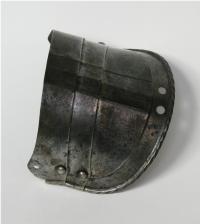
Arm plates circa 1560
Comprising 3 plates with a rolled and roped border and parallel recessed band along the exposed edge. Central recessed band with central crease. Each of the narrow plates with bevelled edges and a central filed notch. Roping and other decoration very crisp and clean. Rolled border filled with wire. From the personal collection of Claude Blair.
Not for sale.
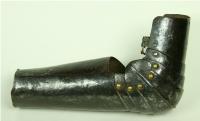
Arm circa 1560
Full vambrace of two plates secured at the back with two inset hinges and a pin on the inner plate engaging a hole in the outer plate on the front, rounded cop with small wing and raised central rib, semi-tubular upper vambrace with a buckle to secure it to the arm, cop articulated to the vambrace by two lames above and below. Likely part of an armour for a child. Upper vambrace plate with 3 pairs of engraved lines, cop and lames with matching pairs of lines at the edge of the plates. Russet finish. Copper alloy capped iron rivets (one cap missing) on the outside, smaller plain heads on the back.
Dr. Peter Parsons Collection (2011)
Weight: 14.6 ounces (415 g).
Not for sale.
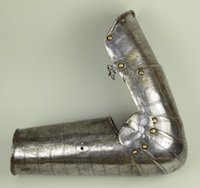
Arm harness circa 1560
Full vambrace of two plates joined by a hinge at the back and a pin that engages a hole in the outer plate on the outside, rounded cop with small wing, semi-tubular upper canon of two plates, cop articulated with one plate above and below. Decorated with triple horizontal lines. Inward-turned finely roped rolls at the wrist, elbow and top of the upper canon. The upper canon has a buckle to secure the arm. Almost certainly from an armour for a child due its size and proportions. Likely originally rough from the hammer. Rusted and lightly cleaned. Upper arm with 710 or 71D in white paint. Similar in overall form to A-202, with differing details.
Weight 1 pound 4.6 ounces (585 grams).
Not for sale.
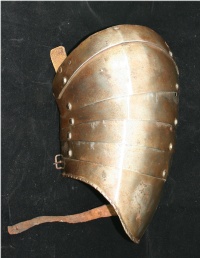
Munion Shoulder circa 1560-1600
formed of 6 lames. 2nd lame with significant shape. Lower lame formed to the elbow with inward turn at the lower edge. Comparable items include item number A-118, item number A-23, item number A-76, and the now separate shoulder from item number A-247.
Not for sale.
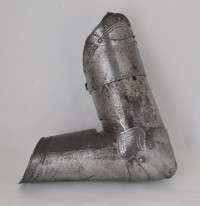
Arm harness circa 1560-65
For the left arm. Consisting of an upper cannon 4 plates, two small ones at the top, and the two large plates forming a turning collar with slots on the inner plate and rivets. Small cop with embossed quatrefoil at the point and small wing with rolled edges. Lower canon of 2 plates. Cop secured to the vambrace by one lame above and below. The inside of the elbow covered by thirteen small plates. Brunswick, from the house of Hanover.
The details of the inside elbow lames illustrate how it was constructed. Originally the plates would not be exposed in the way they are in the images since it would have been secured to the upper and lower cannons of the vambrace. Since these leathers are for the most part lost or broken, I have exposed the plates. The central plate is formed like a narrow football. This plate is the inner-most plate. There are 6 curved plates on each side. They are articulated near their ends. The central two are riveted through the same point and the central plate, the rest are each secured to the one before. The total assembly was originally then secured to the upper and lower cannons of the vambrace by three leather straps each. These straps remain on the lower cannon of the vambrace and the rivets that used to secure them to the elbow plates can be seen on the loose plate. One of these still secures the lames to the upper cannon, the other 2 have been lost. The rivets that secured these straps to the upper and lower cannons can be seen in the external pictures of the arm.
This arm was nicely etched. Etching is in bands down the outside, and sides of the arm, around the borders, covering the wing, and on each of the plates inside the elbow. The style and details can be seen in the pictures of details after much of the paint and some rust was removed during restoration. The etching is a combination of foliate scroll work, roped bands, bands, fruit, granular backgrounds and playful faces. The small wing is etched in the center of the wing, in the border band, up onto the cop and the edge is decorated with a narrow rolled and roped border where the roping changes direction on each side and is accented by 3 vertical lines.
Not for sale.
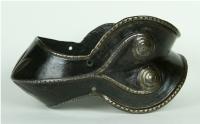
Elbow cop circa 1560-80
North German. Possibly from a black and white armour. Formed of a single piece with a riveted joint at the back. Cop rising to a slightly rounded crease at the center. Center of the point with embossed leaves. The center of the cop with a raised ridge which flows into a pair of volutes on the wing. The ridge, volutes and edge of the wing and cop crenelated. Surface with later black.
Dr. Peter Parsons Collection (2011), Peter Dale (1986), Howard Blackmore FSA
Not for sale.
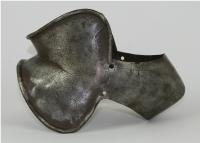
Elbow cop circa 1560-90
Of bracelet form with inward turned rolls on the wing, formed of one piece joined at the back. This cop would have been secured to lames and articulated to the vambrace plates. The cop is deep coming to a rounded point. Ex. Royal House of Hanover.
Not for sale.
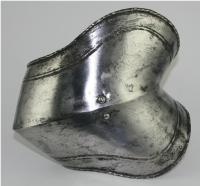
Elbow cop circa 1560-90
Of bracelet form with inward turned finely roped rolls along the edges with a parallel recessed border and additional recessed line. Formed of one piece joined at the center of the wing. The cop rises to a blunt crease at the center. This cop would have have been secured to the vambrace by a leather strip secured to the pairs of rivets in the middle of the front and back of the cop. The roping on the edge changes direction at the widest part of the wing at the front and the back. The transistion includes two lines that go straight across the roll. Ex. Royal House of Hanover.
Maximum width of the wing 7 in. width at the center of the cop 4 3/4 in. inner part of wing to point 6 3/4 in.
Thickness varies significantly - it is thickest at the point where it reaches .070, most of the rest of the area is .040-.060. There are some thin areas which measure .030.
Not for sale.
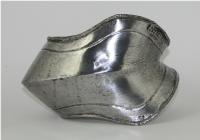
Elbow cop circa 1560-90
Of bracelet form with narrow inward turned roped rolls along the edges with a parallel recessed line. Formed of one piece joined at the center of the wing. The cop rises to a blunt crease at the center. The cop is of medium size. This cop would have have been secured to the vambrace by a leather strip secured to the rivets in the middle of the front and back of the cop. The roping changes direction at the wide point of the wing, at the front there are 2 perpendicular lines, at the back they just chanage direction - intersecting in a V form. There are assembly/association marks on the wing - 2 punched points on one side and fourteen (in 2 lines of 7) on the other side. The recessed lines end near the center of the wing (where it becomes too narrow for them to be there) and at the back. Ex. Royal House of Hanover.
Cop form and decoration the same as the elbows on item number 18 in the exhibition of Brunswick armour at the Tower of London April 10-Oct. 31 1952.
Not for sale.
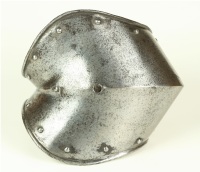
Two Elbow cops circa 1560-90
Nearly a pair. Open at the inside with inward turned rolls along the edges with a parallel recessed border. The cop rises to a blunt crease at the center. The cops are relatively narrow with broad wings. These cops would have have been secured to the vambrace by a leather strip secured to a pin through the hole in the middle of the front of the cop. There are also rivets for securing a strap around the elbow. Ex. Royal House of Hanover.
Not for sale.
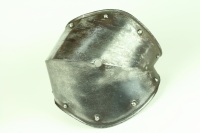
Two Elbow cops circa 1560-90
Nearly a pair. Open at the inside with inward turned roped rolls along the edges. The roping changes direction at the wide point of the wing. The cop rises to a blunt crease at the center. There is a line of rivets around the edges of the cops which would have secured a leather strip. There are also rivets in the center of the wing and back edge and a larger central hole. These cops would have have been secured to the vambrace by a leather strip secured to a pin through the hole in the middle of the front of the cop and a strap around the elbow. One of these elbows appears to show signs of the original finish. These pieces were heavily coated in oil and have gone through relatively few owners. There appear to be areas of surface finish which have not been heavily oxidized or recleaned repeatedly. This can be seen on the lower half of the cop. The surface appears to have been polished over signs of grinding. Ex. Royal House of Hanover.
Not for sale.
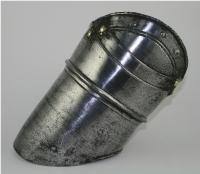
Upper cannon circa 1560-90
Upper arm for use with floating elbow. Formed with a turner - the upper segment of one large plate and two small articulating lames on the outside. The upper is secured to the lower by a raised ridge on the upper which engages flare on the lower plate. There is a small hook on the inside to secure the pauldron strap. The upper edge with an inward turned roped roll with two parallel ridges. A narrow outward turn at the inside of the elbow. Rivets on the upper plate would have secured a leather tab used to lace the arm to the clothing. pairs of holes at the bottom would have secured the leather strap for the elbow. Ex. Royal House of Hanover.
Height of the lower section 5 1/2 in. tapering down to 2 in. at the inside measured from the center of the raised ridge for rotation. Upper 5 in. on the outside and 1 4/3 on the inside. Diameter 5 1/4 - 5 1/2 on the upper and 4 3/4 on the lower.
Thickness of the lower generally .030-.045 with some small portions reaching .050. The main plate of the upper thicker - .050-.060 with some small portions reaching .070. This difference in thickness appears to be intentional. The additional thickness to one section would likely help the rotator resist bending so that it would continue to work under use.
Not for sale.
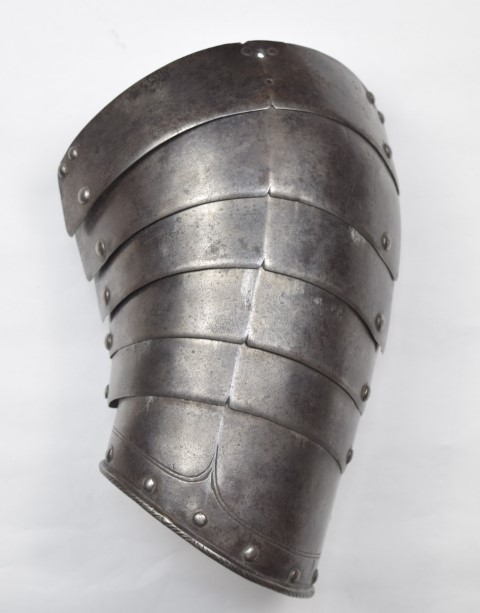
German (possibly Brunswick) Munion shoulder from a pair of munions circa 1570
Very full shape, 6 plates, creased center line with filed notch. Bold roped lower border with double incised line decoration. Originally smooth finish, clean light gray patina. Lower buckle for attachment to arm. Original sliding rivets in rear and 2 bands of old leather. The lower plate is somewhat deformed, it is curled more than it would have been originally. This exaggerates the taper in the arm. Comparable items include item number A-118, item number A-138, item number A-76, and the now separate shoulder from item number A-247.
Not for sale.
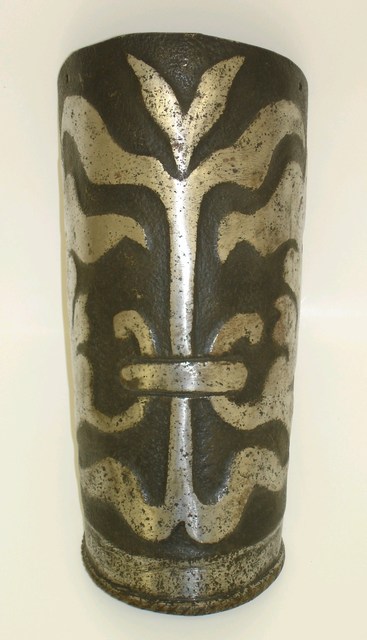
German outer plate from a black and white vambrace third quarter of the 16th c.
With complex raised decoration - probably from a highly decorated black and white 3/4 harness similar to examples in Graz. Shows signs of aggressive rusting and repainted black and cleaned raised surfaces.
Not for sale.
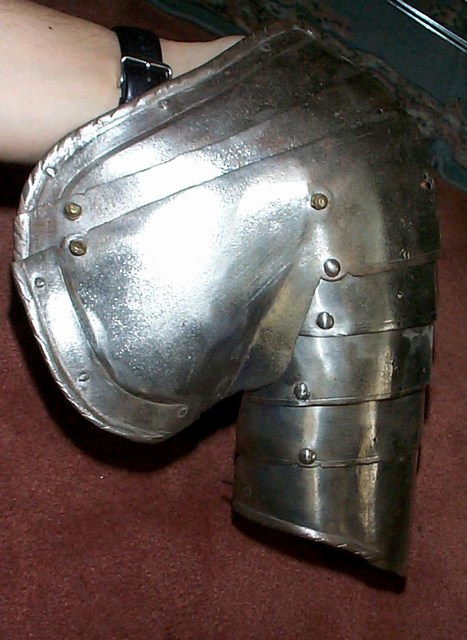
Italian Pauldron late 16th cent
Large main plate overlapping those above and below. 2 plates above, 4 below. Main edges with inward-turned rolls and recessed borders. For use with a floating elbow or with elbow gauntlets. Brass-capped rivets. Leathers and some rivets replaced. Top plate cracked at the center with a modern riveted patch.
Thickness varies between .022 and .058 in., mostly .035-.040 in. There seems to be very little pattern to the thickness variation. There has certainly been some loss due to oxidation.
Measurements: height at the crease measured over the outside 12 1/2 in. length of the top of the main plate 17 3/4 in. (9 behind the crease, 8 3/4 in front).
Weight: 1 pound 13.6 ounces (840 g).
Not for sale.
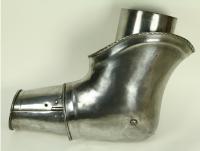
German Arm Harness circa 1570
Formed of a closed vambrace formed of an inner and outer plate secured by an inset hinge on the front and a pin on the inner plate that engages a hole in the outer plate at the back. The cop is slightly rounded and secured to the upper and lower cannons by one lame above and below the cop. The upper canon formed of 2 plates with a turning collar formed by a raised ridge on the upper (outer) an a flare on the edge of the lower (inner) plate. The wrist and inner elbow are bordered by rolled and roped borders. The wing on the cop is formed from a separate plate and secured by 2 rivets. The arm includes a tournament reinforce formed to the elbow and secured to the cop by a bolt at the front and a pin at the point of the elbow.
Weight: 4 pounds 3.8 ounces (1,925 g) including reinforce.
Not for sale.
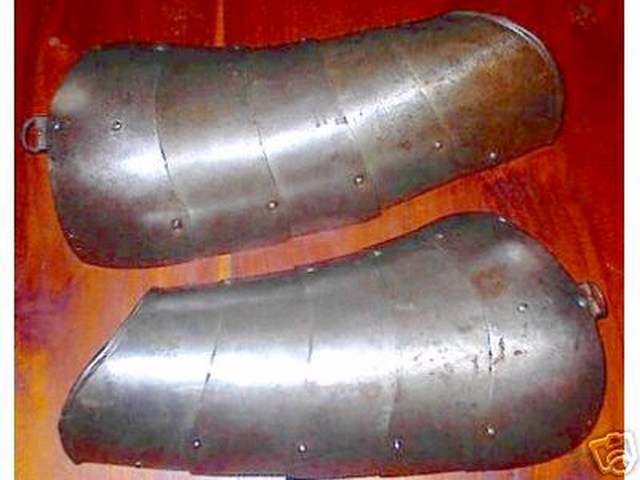
Shoulder plates late 16th, early 17th c.
Shoulders for a pair of munions. composed of 5 plates each. bottom plate with rolled edge. When purchased the plates were secured by rivets front and back. They have since been re-leathered with internal buff straps. Comparable items include item number A-118, item number A-138, item number A-23, and the now separate shoulder from item number A-247. Now temporarily secured to item number A-159 which matches well. This unit is now displayed as part of the composed half suit item number A-161.
Not for sale.
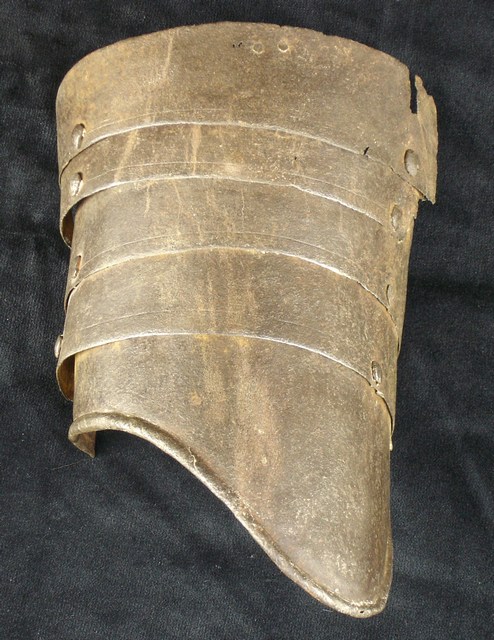
plates Late 16th cent.
5 lower plates from a pauldron. Plates originally atached with sliding rivets at the back and leathers at the front and center. Each plate decorated with an incised line. Bottom plate formed to the elbow and with a rolled and roped border.
Not for sale.
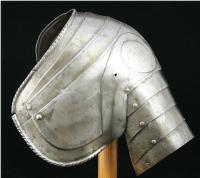
Pauldron late 16th century
Main plate with embossed sworls on front and back. Recessed borders. Large main plate with 2 upper plates. And 4 lower plates.
Measurements: length of top of main plate 20 5/8 inches - 10 1/8 behind the crease, 10 1/2 in front.
Weight: 2 pounds 0.8 ounces (930 g).
Not for sale.
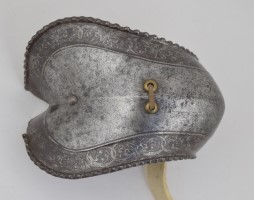
Couter (elbow) circa 1570
South German for light field use. Possibly Augsburg. For the left elbow. Constructed in one piece to be secured to the arming doublet by laces. Open at the rear, with a medial ridge. Edges with notched inward-turned rolls with a band of etching along the border.
Not for sale.
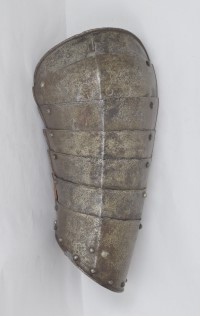
Spaulder circa 1580
Formed of 7 upward-lapping plates. The top two plates are attached by a sliding rivet at the back, central leather and a rivet at the front. The remaining plates are attached with sliding rivets at the back and leather strips at the center and front. All leathers originally secured to the plates with 2 rivets on each plate. Full rolled and roped edges at the top, front and bottom. Raised edge at the rear. Very nice form, swelling up to fit the shoulder. Central crease. Similar in construction to the spaulders on Inv. Nr. A1285 in Vienna dated c. 1590..
Overall height 14 1/4 with the rear sliding rivets collapsed and 15 1/2 inches when extended (slots vary in length, generally 1/2-5/8 inch long and 2 are not presently sliding due to tight rivets and later internal paint), width 7 1/2 inches at the widest point on the outside of the rolls and 5 1/8 inches at the elbow - measured from the outside of the roll to the outside of the roll diagonally (the lower rear corner is curved in at the back so that the edges are 4 5/8 inches apart). The rolls are very small - app. 1/8 in wide.
Weight 1 pound 11.2 ounces (770 g).
Not for sale.
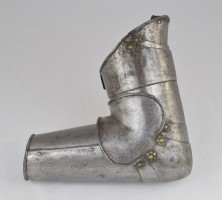
Arm harness circa 1580
Left arm formed of a tubular upper cannon fitted with a turner of 3 lames. The upper and lower are secured by rivets which slide on long slots in the lower plate. The top edge of the turner is bordered by a narrow outward-turned roped roll . Where the plates overlap the roll is stepped to that it fits cleanly when fully extended. The two turner plates are overlapped, riveted and stepped so that the seam is flush on the outside. The cop of bracelet form which joins at the back with a single lame above and below. The vambrace formed of an inner and outer plate secured by one inset hinge on the inside (secured by 3 rivets on each side) and two pins on the outside. The main edges with roped inward turns. These have a typical Brunswick form with a crease along the outside. Most main rivets with dapped brass caps, many of them with rosette washers. There is a small clip on the inside of the turner which would secure the pauldron strap. Ex. Royal House of Hanover.
Not for sale.
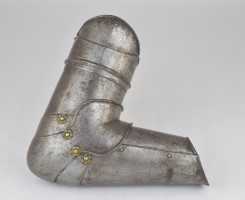
Arm harness circa 1580
Right arm formed of a tubular upper cannon fitted with a turner of 2 lames. The upper and lower are secured by a raised, roped ridge in the upper that is engaged by a flare in the lower plate. The cop of bracelet form joined at the inside - the center of the flare - with a single lame above and below. The vambrace formed of an inner and outer plate secured by one inset hinge on the inside and two pins on the outside. The main edges with roped inward turns. Many of the rivets - primarily those on the visible side - are capped with dapped brass caps. The four outer (visible) articulation rivets have brass rosette washers. The arm has a typical Brunswick form with a crease along the outside. There is a small clip on the inside of the turner which would secure the pauldron strap. Ex. Royal House of Hanover.
Not for sale.
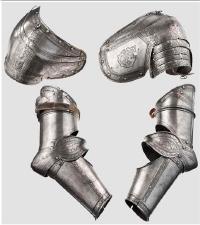
Arms circa 1590
Italian. Good quality Italian arm harness and pauldrons etched in the characteristic Pisan fashion. Assymetrical pauldrons the left covering more than the right. Formed of a main plate overlapping two plates above and four smaller plates below. The lower plates on sliding rivets at the back and leathers at the center and front. The top most plates secured by pivoting rivets at the front and back. The next plate is secured to the main plate by a pivoting rivet at the back and a leather at the front and in the center of the back. Left formerly fitted with a mount for a reinforce. Arms with tubular upper cannons, two piece lower cannons connected by a bracelet couter with one lame above and one below the cop. The upper incorporating a turning collar, the upper section with two smaller plates articulated at the ends. Etching in bands along borders and at the center of each element primarily consisting of cable patterns and trophies of arms. Some leathers replaced, others missing. Some later rivets used to secure plates in the pauldrons. Some loss at the back of the left pauldron and some wear in the etching in the center of the back of the left pauldron.
Not for sale.
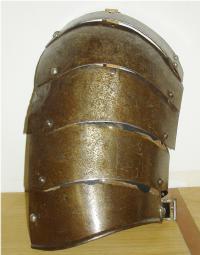
Shoulder from a munion circa 1600
Formed of 5 plates with holes for attachment with leathers at the back, center and front. Currently secured with modern leathers at the front and center and solid rivets in the back. The top plate relatively narrow and the bottom one with an inward-turned roll at the bottom. The second plate is slightly more dished than the rest forming a primitive cop over the point of the shoulder. Each of the plates forms a slight arc and is wider at the back than the front. This munion is comparatively simply formed.
Measurements: app. measurements of the hights of the plates - top 1 1/2, 2nd 3, 3rd 2 3/4, 4th 2 3/4, final 2 3/4. Top plate app. 8 1/2 in. long.
Weight: 1 pound 2.8 ounces (530 g).
Not for sale.
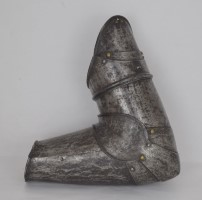
Arm harness circa 1600
Left arm formed of a tubular upper cannon fitted with a turner of 3 lames, the upper lame retains 3 rivets which secured a leather tab to lace the arm to the sleeve. The upper and lower are secured by a raised ridge in the upper that is engaged by a flare in the lower plate. The cop of bracelet form joined at the back with a single lame above and below. The vambrace formed of an inner and outer plate secured by two external hinges on the inside and a pin on the outside. The main edges with inward turns. The surface is rough from the hammer with remains of oxide finish. There is a pin on the outside of the main plate of the turner to secure the arm to the pauldron and a rivet on the inside securing a piece of leather that would originally have been a loop to secure the pauldron strap. The main edges are decorated with incised lines. Many of the rivets retain dapped brass caps. Ex. Royal House of Hanover.
Weight 3 pounnds 5.2 ounces (1,510 g).
Not for sale.
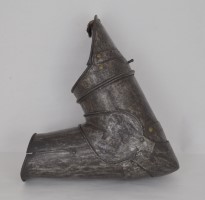
Arm harness circa 1600
Left arm formed of a tubular upper cannon fitted with a turner of 3 lames. The upper and lower are secured by a raised, roped ridge in the upper that is engaged by a flare in the lower plate. The cop of bracelet form joined at the back with a single lame above and below. The vambrace of slight tubular form constructed from an inner and outer plate secured by one inset hinge on the inside and a pin on the outside. The main edges with roped inward turns. The surface is rough from the hammer with remains of oxide finish. There is a pin on the outside of the main plate of the turner to secure the arm to the pauldron. The main edges are decorated with incised lines. Many of the original rivets with dapped brass caps remain. The upper plate retains the leather tab used to secure the arm to the arming doublet. The hole at the inside of the turner plate would have secured a leather loop to secure the pauldron strap. The cop is cracked in 2 places. Ex. Royal House of Hanover.
Weight: 2 pounds 15.6 ounces (1,345 g).
Not for sale.
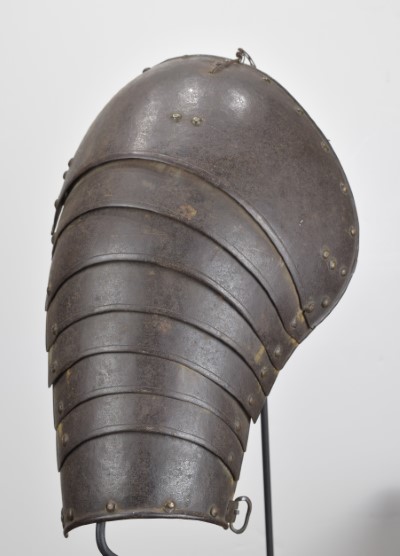
Spaulder circa 1600
Interesting atypical form. Formed of one large plate with seven lower plates undrlapping each other. Bottom plate somewhat taller. Plates taper aggressively from the wide form at the top of the shoulder to the narrow form at the bottom where it would fit around the arm. The natural form (even with the compressed leathers) curves forward. The upper front extends out to allow the piece to fit over the breastplate. Front of the bottom plate with a buckle of oval form secured by a simple external iron plate mount (most of tongue missing). Rosette washer at the back where the corresponding strap would have been secured. Upper and lower edges with inward turned rolls. Front and rear with simple bumps. Secured internally by three leathers. Rivets around the top and bottom edges to secure a leather strip. Iron rivets with dapped copper alloy caps on the exterior. Edges where the plates overlap decorated with a single incised line. Rough from the hammer. Good old black finish. Center leather broken in the top two lames.
Weight 2 pounds 12.2 ounces (1340g).
Thickness: significant variability. Much of the top lame is .070 inch (generally varying from .068 to .072). Bottom lame generally .050 inch. Where measurements were easy, intermediate lames generally .040-.050. In most places below the main lame the overlaps defined by the current (likely working life) leathers are such that more than 3/4 of many of the area covered by the intermediate lames is covered in two layers of steel. Additional bend is provided at the 3rd lame from the top which has significantly less overlap in the back, which helps to provide the forward cast to the shape of the shoulder.
Not for sale.
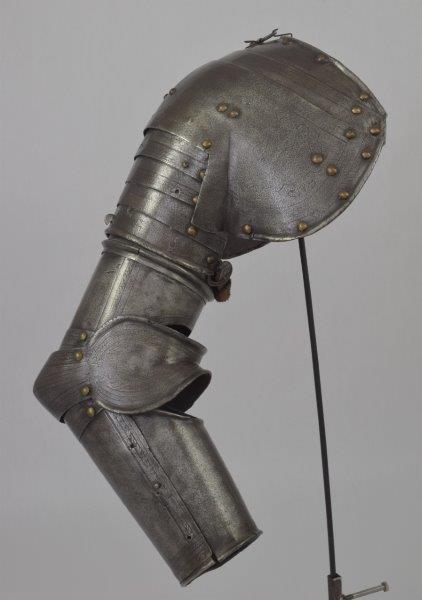
Pauldron and arm circa 1610
Etched in the 'Pisan' fashion. Separate pauldron and arm. For the right arm. Pauldron of 7 lames, 2 above and 4 below the large main plate (similar form and etching, but the right pauldron somewhat larger) The uper plates of the right pauldron are currently secured to the main plate by a rivet at the front and the back. Holes on the plates indicate that the second plate was originally secured to the main plate with a rivet at the back and leathers at the front and center. Outer edge of the main plates with inward turned and roped border. Bottom edge of the bottom lame turned n the same manner. Rectangular hole in the center of the bottom plate to engage a turning pin in the arm harness. Strap and buckle on the inside of the bottom lame to secure it to the pauldron. Arms formed of a tubular upper cannon with rotating collar, lower cannon of inner and outer plates attached by pairs of hinges at the back and a pin on the inner plate engaging a hole in the outer plate at the front, elbows of bracelet form joined at the back with rolled edges on the wing attached to the uper and lower cannons by one articulating lame.
Not for sale.
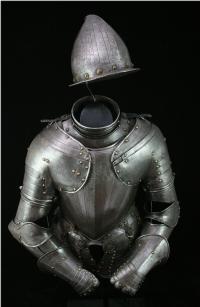
Pauldron and arm circa 1610
Etched in the 'Pisan' fashion. Separate pauldron and arm. for the left arm. Pauldron of 7 lames, 2 above and 4 below the large main plate (similar form and etching, but the right pauldron somewhat larger). Outer edge of the main plates with inward turned and roped border. Bottom edge of the bottom lame turned in the same manner. Rectangular hole in the center of the bottom plate to engage a turning pin in the arm harness. Strap and buckle on the inside of the bottom lame to secure it to the pauldron. Arms formed of a tubular upper cannon with rotating collar, lower cannon of inner and outer plates attached by pairs of hinges at the back and a pin on the inner plate engaging a hole in the outer plate at the front, elbows of bracelet form joined at the back with rolled edges on the wing attached to the uper and lower cannons by one articulating lame.
Not for sale.
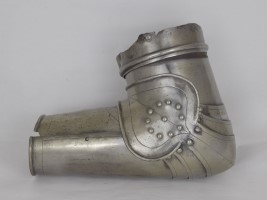
Left Arm circa 1620
Left arm. Purchased together with item number A-137a. Cop wing decorated with a circle of 10 rivets surrounding one in the center. Both composed of upper cannon with turning collar, bracelet cop secured by 2 lames above and 2 lames below, lower cannon formed of 2 plates secured by two external hinges at the back and pin engaging a hole at the front. In general plates with engraved line decoration. Rolls at the wrist, inner elbow and on the wing of the cop. Turner on the upper canon with rivets and holes that would have secured it directly to the pauldron. Arm completely original. Similar in form and style to the arms on a 3/4 armour on display in the Cleveland Museum of Art on loan from the RA Inv. II 98/IV.863 38.2008.
Weight: 2 pounds 6.4 ounces (1,090 g).
Not for sale.
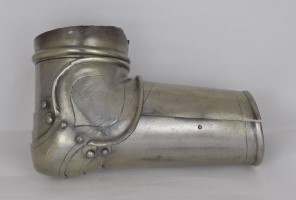
Right Arm circa 1620
Right arm. Purchased together with item number A-137. Both composed of upper cannon with turning collar, bracelet cop secured by 2 lames above and 2 lames below, lower cannon formed of 2 plates secured by an inset internal hinge at the back and pin engaging a hole at the front. In general plates with engraved line decoration. Rolls at the wrist, inner elbow and on the wing of the cop. Turner on the upper canon with rivets and holes that would have secured it directly to the pauldron. Lower canon of the vambrace likely associated. Similar in form and style to the arms on a 3/4 armour on display in the Cleveland Museum of Art on loan from the RA Inv. II 98/IV.863 38.2008.
Weight: left 2 pounds 8 ounces (1,135 g).
Not for sale.
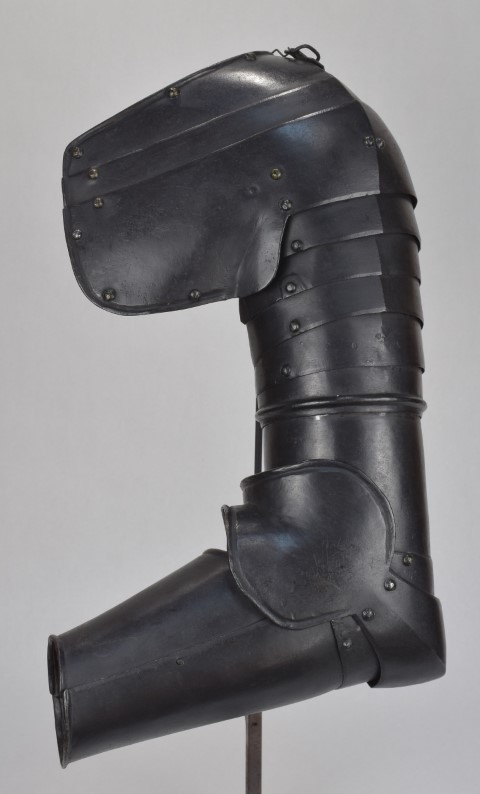
Arms and Pauldrons circa 1620
Two well matched arms. Pauldrons of 7 plates the center one (third from the top) larger and overlapping the upper and lower plates. The top three plates extended to cover the shoulder and overlap the breast and back plate. The outer edge of these plates with a simple inward turned roll bordered by a narrow, rounded recess and a line of rivets that secure remains of a lining leather. The bottom four plates shaped to the arm. The seven plates creased vertically at the center. Top 3 plates secured front and back with pivoting rivets. The upper plates include interior leathers to limit movement. Two in the case of the left and one in the right. The bottom five secured by sliding rivets at the back and leathers at the center and front. Permanently secured to the arms with turning collar. Turning collar engaging a closed upper canon. Closed lower canon formed of an inner and outer plate with a simple inward turned roll at the wrist (the left with a matching turn at the elbow), the plates secured by a pair of hinges at the back and pin at the front. Bracelet couter with central horizontal crease in the cop and wing bordered by a plain inward turn matching the pauldrons. The bracelet is closed by a riveted seam at the back. The cop is secured to the canons by one plate above and one plate below. All overlapping edges of the plates with rough bevels bordered by a single engraved line. The left slightly longer.
Not for sale.
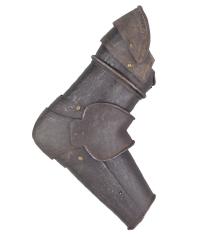
Arm early 17th c.
Italian. Rough from the hammer. Vambrace with very slight tulip shape on the outer plate, inner plate secured by an inset hinge at the back and a pin engaging a hole in the outer plate at the front. Deep, broad cop with slight pointw at the center of the top and bottom. One lame below and above securing the cop to the vambrace. Upper formed of two large plates and two further smaller plates. The bottom two forming a turning collar. The top two secured to each other and the remainder by sliding rivets at the back and with leathers at the front and center. Leathers secured by pairs of rivets in each plate (leathers lost). interior edges of vambraces, cop and lames with pairs of chisel assembly marks. Engraved lines generally tripled parallel to the edges. Edges with inward turned plain rolls except at the elbow of the upper vambrace plate where the roll is turned outward.
Measurements: weight: 4 pounds 9.6 ounces (2.090 kilo).
Provenance: Ex. JW Higgins Armoury (inv. no. 927). Dr Bashford Dean, Riverdale, New York, purchased from his estate 28 September 1929.
Not for sale.
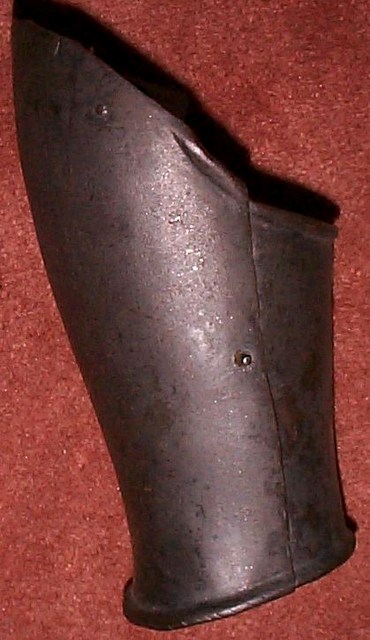
Vambrace 17th century
Good 'tulip' form. Rolled at the wrist. Hinges and pin attachment remain. Good, stable black patina.
Not for sale.
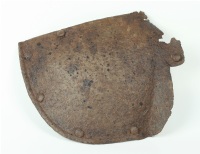
Rear part of the main plate of a Pauldron. In excavated condition. 17th cent.
In excavated condition. From the personal collection of Claude Blair.
Not for sale.

Remains of an elbow cop 20th
part of an elbow.
Not for sale.